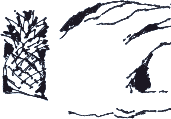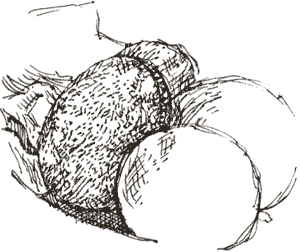
WE CALLED IN Alderson's, the stationers on Horbury High Street, yesterday and, as usual, took a look at the pens. Elaine, the assistant, mentioned that a boy from the local high school had called in and said that he felt he needed to change the style in which he draws cartoons. He was delighted when he discovered that he could buy an American pen he'd read about, the twin tip Sharpie permanent marker.
If this is what the new generation are using, I had better give it a go!
You can draw an outline with the finer end then switch to larger end to add areas of tone. It certainly gives a graphic effect, which would be suitable for cartoons. My main problem with it is that, being a bleed-proof permanent marker, the black goes straight through the cartridge paper in my sketchbook, so, if I do use it, I'll have to make sure I don't mess up an existing drawing on the other side of the paper.
The Art of Handwriting
 The fir
tree (right) at
my mum's was drawn at the weekend using a Parker Reflex fountain
pen which
I keep loaded with blue-black cartridges
for writing letters. And the occasional drawing of course.
The fir
tree (right) at
my mum's was drawn at the weekend using a Parker Reflex fountain
pen which
I keep loaded with blue-black cartridges
for writing letters. And the occasional drawing of course.
A friend wrote recently saying that she fervently believes that nothing can compare with handwritten communication and that she always tries to encourage the younger generation not to neglect the 'personal' art of handwriting.
![]()
She asks which pen I used to sign the copy of High Peak Drifter (which itself is entirely hand-written) that I sent her. She remarks on how well the writing 'flows' along, and thinks it may be my faithful Parker.
It probably was. I sometimes sign a book using a fibre tip when I'm concerned that it get closed before the ink dries - the coated paper in a printed book means that fountain pen ink takes a while to dry so, when I'm getting a copy ready to post, I often prop the book open with the pen.
Sometimes I'm handed a ballpoint pen to sign a book with, and with my shaky hands I'm always afraid that it's going to go slipping and sliding all over the place. Like my friend says, I like the flow of a fountain pen.
 Edding
v. Pilot
Edding
v. Pilot
![]() I've
been using my Edding 1800 0.5 mm fibre tip a lot
recently but I was discussing pens with my friend John Welding and
he pointed out, and I have to agree with him, that when you're using
the Edding you have to hold it perpendicular to the page. He's been using
the rotring XONOX Graphic Pen - which because of production
problems is temporarily unavailable in the UK - which he says has a tip
that allows you to hold the pen at an angle to the paper.
I've
been using my Edding 1800 0.5 mm fibre tip a lot
recently but I was discussing pens with my friend John Welding and
he pointed out, and I have to agree with him, that when you're using
the Edding you have to hold it perpendicular to the page. He's been using
the rotring XONOX Graphic Pen - which because of production
problems is temporarily unavailable in the UK - which he says has a tip
that allows you to hold the pen at an angle to the paper.
![]() I
couldn't remember the name of the pen John had mentioned, but I didn't
spot anything like it in Alderson's, so I went for a Japanese Pilot
Drawing Pen which features DR pigment ink which is claimed to
'resiste a la lumiere et a l'eau'. It's easier to draw with than my old
Edding but whether that is partly because the Edding has been used so
much and I've worn down the fibre tip, I'm not sure.
I
couldn't remember the name of the pen John had mentioned, but I didn't
spot anything like it in Alderson's, so I went for a Japanese Pilot
Drawing Pen which features DR pigment ink which is claimed to
'resiste a la lumiere et a l'eau'. It's easier to draw with than my old
Edding but whether that is partly because the Edding has been used so
much and I've worn down the fibre tip, I'm not sure.
I've enlarged the drawing of the avacado pear (left), stippled and cross-hatched with the new pen. And I could have added watercolour, because it is, as they claim, water resistant.
'I'm still trying to hang onto my ebay sourced stock of rotring rapidoliners..' says printmaker Janis Goodman, 'but I'd recommend also the Faber-Castell PITT art pen which is Indian ink waterproof and *** on light fastness -made in different thickneses and quite pleasant to use..'
Links
John Welding, currently starting to work on a much larger scale!